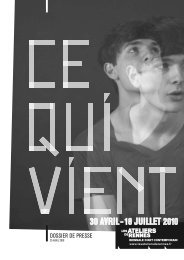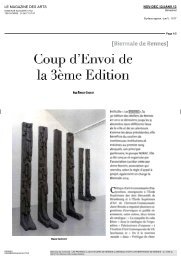Download here the Visitor's guide. - Les Ateliers de Rennes
Download here the Visitor's guide. - Les Ateliers de Rennes
Download here the Visitor's guide. - Les Ateliers de Rennes
You also want an ePaper? Increase the reach of your titles
YUMPU automatically turns print PDFs into web optimized ePapers that Google loves.
14<br />
<strong>Les</strong> Prairies<br />
Thus, this figure constructed and <strong>de</strong>fined in relation to spaces and territories is to be<br />
un<strong>de</strong>rstood in terms of an attitu<strong>de</strong> towards space. Attitu<strong>de</strong>s and way of life shape an<br />
environment, ei<strong>the</strong>r in an authoritarian mo<strong>de</strong> or through a more intimate cooperative<br />
interaction. Conquest is embodied by a variety of spatial positions that confront one<br />
ano<strong>the</strong>r: from <strong>the</strong> American pioneer to <strong>the</strong> post-colonial migrant. Botany also provi<strong>de</strong>s<br />
a useful mo<strong>de</strong>l for examining <strong>the</strong> relationship between <strong>the</strong> “individual” and <strong>the</strong><br />
environment: t<strong>here</strong> are pioneering plants that prepare <strong>the</strong> earth for vegetables that will<br />
follow later, while o<strong>the</strong>rs colonize ecosystems and <strong>de</strong>stroy <strong>the</strong>ir diversity.<br />
A FLAT EXPANSE<br />
The Prairie: a grassy expanse, w<strong>here</strong> space and an open horizon spread out in all<br />
directions. It is a common, shared, scenic, and poetic space and even a cinematic cliché<br />
in Europe, and America. Natural or artificial prairies are home to a range of species, and<br />
vary with <strong>the</strong> climate, latitu<strong>de</strong>, or continent, having specific flora and fauna according to<br />
w<strong>here</strong> <strong>the</strong>y are (<strong>the</strong> African savannah, <strong>the</strong> Russian steppes, or <strong>the</strong> Argentinean pampas,<br />
for example). Prairies also belong to <strong>the</strong> built world.<br />
Thus, <strong>the</strong> American prairie represents <strong>the</strong> experience of an uncontained expanse –<br />
unlimited space and boundless horizons. And it is precisely this flat and monotonous<br />
geography that Gertru<strong>de</strong> Stein transformed into a mo<strong>de</strong>rn poetic experience. She laid it<br />
bare and <strong>de</strong>tached it from its origins. Flatness also characterizes <strong>the</strong> generic European<br />
green prairie - geographical and poetic flatness. Monotony produces repetition.<br />
Repetition is an act that is ma<strong>de</strong> real when carried out. It produces a poetics that begins<br />
with action ra<strong>the</strong>r than with an i<strong>de</strong>al.<br />
When we explore <strong>the</strong> horizontal, we discover <strong>the</strong> verticality of grass: “A flat expanse<br />
seen horizontally from above; yet it is formed by a multitu<strong>de</strong> of upright stems whose<br />
verticality gives it its green quality” (Francis Ponge 1 ) . This takes us from <strong>the</strong> flat<br />
expanse to <strong>the</strong> three dimensional expanse: a body occupies an area in space according<br />
to <strong>the</strong> primary <strong>de</strong>finition of <strong>the</strong> term. An expanse is not just surface area. A literal<br />
interpretation turns space in on itself, and flatness leads to a simple vitality: “<strong>the</strong><br />
awareness that grass is vertical, <strong>the</strong> constant uprising of green that brea<strong>the</strong>s life back<br />
into us”.<br />
Horizontality also gives rise to an egalitarian principle in relationships. They <strong>de</strong>velop on<br />
<strong>the</strong> same plane, which <strong>the</strong>y do not in a vertical, hierarchical organization. Flatness is in<br />
fact an attitu<strong>de</strong>: a way of approaching <strong>the</strong> expanse as a grouping of things, things on an<br />
equal footing, things like <strong>de</strong>ath. But it is a beginning that is beginning <strong>here</strong>.<br />
<strong>Les</strong> Prairies literally expresses <strong>the</strong> flattening of spatial practices. A number of artworks<br />
work with <strong>the</strong> expanse and recognize <strong>the</strong> importance of concrete spaces, of sites in all<br />
<strong>the</strong>ir complexity and <strong>the</strong>ir history. "Occupying <strong>the</strong> ground” seems to be a concern for<br />
artists who have brought <strong>the</strong>ir background of using sites to bear on <strong>the</strong>ir work (Katinka<br />
Bock, Fernanda Gomes, and Guillaume Leblon are examples). O<strong>the</strong>rs <strong>de</strong>compose our<br />
décor (Gyan Panchal), flatten <strong>de</strong>pths (Dove Allouche, Irene Kopelman, Batia Suter), or<br />
<strong>de</strong>velop botanics of <strong>the</strong> soil (Loïs Weinberger).<br />
1. Fr a n c i s Po n g e, La fa b r i q u e d u Pr é, in Œu v r e s c o m p l è t e s, Ga l l i m a r d, Bi B l i o t h è q u e d e la Pl é i a d e, 2002.






